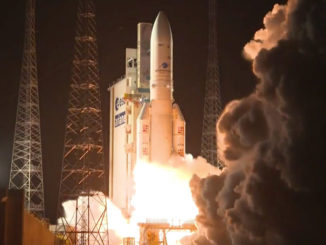STORY WRITTEN FOR CBS NEWS & USED WITH PERMISSION

After withstanding hurricanes and earthquakes, playing central roles in movies like “GoldenEye” and “Contact,” Puerto Rico’s famed Arecibo Observatory, once the largest radio telescope in the world, will be demolished because of cable failures that left its huge detector platform too unstable to attempt repairs.
“After reviewing the engineering assessment, we have found no path forward that would allow us to do so safely,” said Sean Jones, assistant director for the Mathematical and Physical Sciences Directorate at the National Science Foundation.
“We know that a delay in decision making leaves the entire facility at risk of an uncontrolled collapse, unnecessarily jeopardizing people and also the additional facilities.”
Operated by the NSF through the University of Central Florida, the iconic observatory is made up of a fixed 1,000-foot-wide dish antenna built into a bowl-like depression that reflects radio waves or radar beams to a 900-ton instrument platform suspended 450 feet above by cables stretching from three support towers.
For 57 years, the observatory has played a leading role observing deep space targets, bodies in the solar system and, using powerful lasers, the composition and behavior of Earth’s upper atmosphere.
But the beginning of the end came on Aug. 10 when an auxiliary cable installed in the 1990s pulled free of its socket on one support tower and crashed onto the dish below, ripping a 100-foot-long gash.
Engineers were developing repair plans when one of the main 3-inch-wide cables attached to the same tower unexpectedly snapped on Nov. 6, causing the instrument platform to tilt and putting additional stress on the remaining cables.
An analysis showed the cable failed in calm weather at about 60 percent of of its minimum breaking strength. Inspections of other cables showed fresh wire breaks and slippage in several auxiliary cable sockets that were added to the structure in the 1990s.
An engineering firm hired by the University of Central Florida to assess the structure concluded it would be unsafe to proceed with repairs. Even stress tests to determine the strength of the remaining cables could trigger a catastrophic collapse.
Instead, engineers recommended a controlled demolition, bringing down the suspended instrument platform in a way that will prevent damage to other structures at the periphery of the dish by making sure the towers themselves don’t collapse and by ensuring no cables whip into those structures.
“The telescope is at serious risk of an unexpected, uncontrolled collapse,” said Ralph Gaume, director of NSF’s Division of Astronomical Sciences. “According to engineering assessment, even attempted stabilization, or testing the table could result in accelerating the catastrophic failure.
“Engineers cannot tell us the safety margin of the structure, but they have advised NSF that the structure will collapse in the near future on its own.”
Plans for bringing down the instrument platform have not yet been finalized and it’s not yet known whether explosives will be used in a controlled demolition or whether it might be possible to somehow lower the platform to the dish below.
However it plays out, the 1,000-foot-wide telescope will essentially be destroyed. While the laser facility and visitor’s center will hopefully be preserved, the radio telescope itself will be no more.
“For 57 years, this facility has served as a resource for radio astronomy, solar system radar astronomy, space and atmospheric science,” said Gaume. “The Arecibo 305-meter telescope had powerful, unique capabilities, advantages especially valuable.
“That said, we’re confident in the resilience of the astrophysics community and that NSF will be encouraging other facilities to work directly with the Arecibo scientific community and investigators to provide them with appropriate support now.”
Completed in 1963, the Arecibo Observatory was the largest single-dish radio telescope in the world until China’s Five hundred meter Aperture Spherical Telescope, or FAST, began operations in 2016.
The dish antenna, made up of nearly 40,000 aluminum panels, was built into a depression left by a sinkhole. While the dish itself only moves with Earth’s rotation, the instrument platform features a moveable receiver pallet that allows astronomers to “look” at targets up to 40 degrees away from the telescope’s vertical axis.
Along with a half century of astronomical observations, the observatory has been featured in movies ranging from the James Bond thriller “GoldenEye” to “Contact,” based on Carl Sagan’s novel about first contact with aliens.
The observatory also played a role in the search for extraterrestrial intelligence, or SETI. In 1974, the dish was used to beam a crude message into deep space. More recently, the observatory provided the data used by the SETI@home project, which looked for signals using the computing power of thousands of on-line personal computers.



